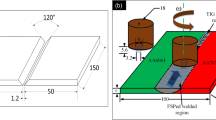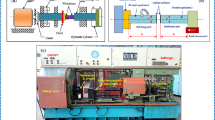Abstract
The capacity of the welded joint can be defined in terms of load-carrying and deformation capacities. For ultra-high-strength structural steels, such as S960 QC, the deformation capacity is a crucial structural property. In this paper, the rotation capacity of fillet weld joints was investigated experimentally and analytically. The rotation capacity of the fillet weld joints under pure bending load is calculated analytically by a model using the elastic peak stress and plastic limit state. The experimental test proved that the plastic load-carrying capacities required by the standards were reached. Additionally, the tests showed that sufficient deformation capacities can be obtained, although fully plastic rotation hinges could not always be reached. The experimental results were in good agreement with the analytically calculated capacities. However, there is a need for some design limitations before more results are available.














Similar content being viewed by others
References
(2005) EN 1993-1-8. Eurocode 3: Design of steel structures, part 1-8: Design of joints
(2005) EN 1993-1-10. Eurocode 3: Material toughness and through-thickness properties
Johansson B (2004) Design of fillet welds with under –or overmatching electrodes. CEN/TC250/SC3/WG S690
Hölbling W, Muller G, Saal H (2005) Tragverhalten von Kehlnahtverbindungen von höcherfesten Feinkornbaustählen. Stahlbau 74, Heft 1
Kuhlmann U, Günther H-P, Rasche C (2008) High-strength steel fillet welded connections. Steel Construction, Design and Research, vol 1
Günther H-P, Hildebrandt J, Rasche C, Versch C, Wudtke I, Kuhlmann U, Wormwald M Werner F (2009) Welded connections of high strength steels for the building industry. IIW XV-1315-09
Knurshid M, Mumtaz N (2011) Static and fatigue design of load carrying welded joints in high strength steels. Master of Science Thesis. KTH Engineering Sciences, Stockholm
Björk T, Toivonen J, Nykänen T (2012) Capacity of fillet welded joints made of ultra-high strength steel. Welding in the Word
Herion S, Fleicher O (2012) Reduction of weld sizes. CIDECT Report 5BY-5/11, Final Report
Knurshid M, Barzom Z, Mumtaz N (2012) Ultimate strength and failure modes for fillet welds in high strength steels. Materials and Design (40)
Miller D K (1998) Consider direction of loading when sizing fillet welds. Welding innovation, vol XV, No 2
Sanei E, Kamtekar A G (1988) Experiments on some arbitrary loaded fillet welds, Welding research supplement, Welding J
Kulak G L, Timler P A (1984) Tests on eccentrically loaded fillet welds. Structural Engineering Report No. 124. University of Alberta, Department of Civil Engineering
Kamrekar A G (1987) The strength of planar fillet welds groups subjected to an eccentric shearing force in their planes. J Construct Steel Res 7
Lesik D F, Kennedy D J L (1988) Ultimate strength of eccentrically loaded fillet welded connections. Structural engineering Report no. 159. University of Alberta, Department of Civil and Environmental Engineering
Vogwell J, Minguenz J M (1999) Analysing of strength on non-continuous weld seams in joints under eccentrically applied load. International journal of mechanical engineering education vol 27, No2
Ng A K F, Driver R G, Grodin G Y (2002) Behaviour of transverse fillet welds, Structural Engineering Report No. 245, University of Alberta, Department of Civil & Environmental Engineering
Khan SUR (2010) Welds in shear, bending, torsion and axial loading. User notes for the analysis & design of weld groups subjected to simultaneously shear, bending, torsion and axial loading. WeldCalc
Kwan YK, Gomez IR, Grondin GY, Kanvinde AM (2010) Strength of welded joints under combined shear and out-of-plane bending. Canadian Journal of Civil Engineering 37
Viitala A (2012) Static strength of fillet welds of ultra-high-strength steels (in Finnish). Bachelor Thesis, Lappeenranta University of Technology, Department of Mechanical Engineering
Vreedenburgh CGJ (1954) New principles for calculation of welded joints, welding J
Penttilä T (2012) Static strength design of fillet welds with conventional methods and new improved design methods based on different boundary conditions (in Finnish). In Proceedings of the 11th Finnish Mechanics Days
Nie C, Dong P (2012) A traction stress shear strength definition for fillet welds. J Strain Analysis Eng Design 47:562
Acknowledgments
The authors wish to thank Rautaruukki Corporation for supplying the materials and TEKES/FIMEC for providing the funding for this project, which is part of the LIGHT project.
Author information
Authors and Affiliations
Corresponding author
Additional information
Doc. IIW-2479, recommended for publication by Commission XV “Design, Analysis and Fabrication of Welded Structures”.
Rights and permissions
About this article
Cite this article
Björk, T., Penttilä, T. & Nykänen, T. Rotation capacity of fillet weld joints made of high-strength steel. Weld World 58, 853–863 (2014). https://doi.org/10.1007/s40194-014-0164-5
Received:
Accepted:
Published:
Issue Date:
DOI: https://doi.org/10.1007/s40194-014-0164-5




